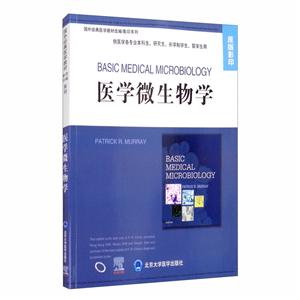-
>
补遗雷公炮制便览 (一函2册)
-
>
方剂学
-
>
(精)河南古代医家经验辑
-
>
中医珍本文库影印点校(珍藏版):医案摘奇·雪雅堂医案合集
-
>
中医珍本文库影印点校(珍藏版):外科方外奇方
-
>
中医珍本文库影印点校(珍藏版):用药禁忌书
-
>
中医珍本文库影印点校(珍藏版):沈氏女科辑要笺疏
医学微生物学/国外经典医学教材改编.影印系列 版权信息
- ISBN:9787565922985
- 条形码:9787565922985 ; 978-7-5659-2298-5
- 装帧:一般胶版纸
- 册数:暂无
- 重量:暂无
- 所属分类:>
医学微生物学/国外经典医学教材改编.影印系列 内容简介
What is the bigger challenge-for a student or the instructor to understand what is important in medical microbiology? Many years ago when I took my first graduate course in medical microbiology, I read thou-sands of pages of text, listened to 5 hours oflectures a week, and performed lab exercises 6 hours a week for 1 year. I was given a wonderful foundation in micro-biology, but I frequently asked the question-that was voiced by all the students-do I really need to know all this stuff? The answer to that question is certainly no, but the challenge is what information is needed.Years later when I set out to write my first textbook on microbiology, my goal was to only give the students what they need to know, described in a way that is informative, factual, and concise. I think I was success-ful in that effort, but I also realize that the discipline of microbiology continues to change as do approaches to presenting information to the students. i am still firmly convinced that my efforts in my first textbook, Medical Microbiology, and subsequent editions are important,forming the foundation of microbiology knowledge for a student. This cannot be replaced by a quick search of the internet or a published review because much of the subject matter presented in Medical Microbiology-epidemiology, virulence, clinical diseases, diagnostics,treatment-is a distillation of the review of numerous research articles and clinical and technical experience.Having stated that, students frequently turn to review books consisting of abbreviated summaries, illustra-tions (should I say cartoons), and various mnemonic aids for mastering this subject. As I have watched this evolution oflearning microbiology, I am struck by the sacrifice that has been made. I believe microbiology is a beautiful subject, with the balance between health and disease defined by the biology ofindvidual organisms and microbial communities. Without an understand-ing of the biology,lists of facts are soon forgotten. But I am a realist and know the burden students face, master-ing not only microbiology but also a number of other subjects. So the personal question I posed was-is there a better way to present to the student a summary of information that is easy to understand and remem- ber? This book is my approach to solving this question. First, almost by definition, it is not comprehensive. Just as I have carefully selected organisms and diseases to present in this book, I have also intentionally not men-tioned others-not because they are unimportant but because they are less common. I have also not presented a detailed discussion of microbial biology and virulence or the immune response of the patient to an infection,but simply presented the association between an organ-ism and disease. Again, I felt those discussions should be reserved for Medical Microbiology. Finally, the orga-nization ofthis book is focused on organisms-bacteria,viruses, fungi, and parasites-rather than diseases. I do this because I thinkit is easier for a student to remember a limited number of diseases assoaated with an organ-ism rather than a long list of organisms (or a signifi-cantly incomplete list) implicated in a specific disease such as pneumonia. Still, patients present with disease and the observer must develop a list of organisms that could be responsible; so to aid the student, i provide this differential diagnosis in the introductory chapter of each organism section (Chapters 2, 12, 18, and 22).I also provide in these introductory chapters an over-view of the classification of the organisms (a structural framework for remembering the organisms) and a list-ing of antimicrobials that are used to treat infections.The individual chapters in Sections 1-4 are organized in a common theme: brief discussion of the individual organisms, a summary of facts (properties, epidemiol-ogy, clinical disease, diagnosis, treatment) provided in a conase table, illustrations provided as a visuallearning aid, and clinical cases to reenforce the clinical signifi-cance of the organisms. Finally, examination questions are provided to help the student assess their ability to assinulate this material. Again, I will emphasize that this text should not be considered a comprehensive review of microbiology. On the other hand, I believe if the student masters this material, he or she will have a firm foundation in the principles and applications of microbiology. I certainly welcome all comments on how successful my efforts are.
医学微生物学/国外经典医学教材改编.影印系列 目录
1 Overview of Medical Microbiology
Viruses and Bacteria
Fungi and Parasites
Good versus Bad Microbes
Conclusion
SECTION Ⅱ Bacteria
2 Introduction to Bacteria
A Word of Caution
Overview
Classification
Role in Disease
Antibacterial Agents
3 Aerobic Gram-Positive Cocci
Interesting Facts
Staphylococcus aureus
?-Hemolytic Streptococci
Streptococcus pneumoniae
Viridans Streptococci
Enterococcus
4 Aerobic Gram-Positive Rods
Interesting Facts
Bacillus anthracis and Bacillus cereus
Listeria monocytogenes
Corynebacterium diphtheriae
5 Acid-Fast Bacteria
Interesting Facts
Acid-Fast Organisms
Mycobacterium tuberculosis
Mycobacterium leprae
Mycobacterium avium Complex
Nocardia Speaes
6 Aerobic Gram-Negative Cocci and Coccobacilli
Interesting Facts
Neisseria gonorrhoeae
Neisseria meningitidis
Eikenella corrodens
Kingella kingae
Moraxella catarrhalis
Haemophilus influenzae
Acinetobacter baumannii
Bordetella pertussis
Francisella tularensis
Brucella Speaes
7 Aerobic Fermentative Gram-Negative Rods
Interesting Facts
Escherichia coli
Klebsiella pneumoniae
Proteus mirabilis
Salmonella Species
Shigella Speaes
Yersinia pestis
Vibrio cholerae
8 Aerobic Nonfermentative Gram-Negative Rods
Interesting Facts
eudomonas aeruginosa
Burkholderia cepacia
Stenotrophomonas maltophilia
9 Anaerobic Bacteria
Interesting Facts
Clostridium tetani
Clostridium botulinum
Clostridium perfringens
Clostridium difficile
Bacteroides fragilis
10 Spiral-ShapedBacteria
Interesting Facts
Campylobacter jejuni
Helicobacter pylori
Treponema pallidum
Borrelia burgdorferi
Leptospira Species
11 Intracellular Bacteria
Interesting Facts
Rickettsia rickettsii
Ehrlichia chaffeensis
Coxiella burnetii
Chlamydia trachomatis
SECTION Ⅲ Viruses
12 Introduction to Viruses
Overview
Classification
Role in Disease
Antiviral Agents
13 Human Immunodeficiency Viruses
Interesting Facts
Human Immunodejiciency Virus(HIV-1)
14 Human Herpesviruses
Interesting Facts
Herpes Simplex Virus Types 1 and 2
Varicella-Zoster Virus
Cytomegalovirus
Epstein-Barr Virus
Human Herpesviruses 6 7 and 8
15 Respiratory Virusesll
Interesting Facts
Rhinoviruses
Coronaviruses
Influenza Viruses
Paramyxoviridae
Parainfluenza Viruses
Respiratory Syncytial Virus
Human Metapneumovirus
Adenovirus
16 Hepatitis Viruses
Interesting Facts
Hepatitis A Virus
Hepatitis B and D Viruses
Hepatitis C Virus
Hepatitis E Virus
17 Gastrointestinal Viruses
Interesting Facts
Rotavirus
Norovirus and Sapovirus
Astrovirus
Adenovirus
SECTIONIV Fungi
18 Introduction to Fungi
Overview
Classification
Role in Disease
Antifungal Agents
19 Cutaneous and Subcutaneous Fungi
Interesting Facts
Dermatophytosis
Fungal Keratitis
Lymphocutaneous Sporotrichosis
Other Subcutaneous Infections
20 Systemic Dimorphic Fungi
Interesting Facts
Blastomyces dermatitidis
Coccidioides immitis and Coccidioides
posadasii
Histoplasma capsulatum
21 OpportunisticFungi
Interesting Facts
Candida albicans and Related Species
Cryptococcus neoformans
Miscellaneous Yeastlike Fungi
Aspergillus fumigatus
Miscellaneous Opportunistic Molds
SECTION Ⅴ Parasites
22 Introduction to Parasites
Overview
Classification
Role in Disease
Antiparasitic Agents
23 Protozoa
Interesting Facts
Intestinal Amoeba
Coccidia
Flagellates
Free-Living Amoeba
Blood and Tissue Protozoa
24 Nematodes
Interesting Facts
Intestinal Nematodes
Blood Nematodes
Tissue Nematodes
25 Trematodes
Interesting Facts
Intestinal Trematode
Tissue Trematodes
Blood Trematodes
26 Cestodes
Interesting Facts
Intestinal Cestodes
Tissue Cestodes
27 Arthropods
SECTION Ⅵ Review Questions
Questions
Answers
Index
- >
我与地坛
我与地坛
¥27.2¥28.0 - >
伊索寓言-世界文学名著典藏-全译本
伊索寓言-世界文学名著典藏-全译本
¥9.3¥19.0 - >
名家带你读鲁迅:故事新编
名家带你读鲁迅:故事新编
¥13.0¥26.0 - >
小考拉的故事-套装共3册
小考拉的故事-套装共3册
¥36.7¥68.0 - >
自卑与超越
自卑与超越
¥12.7¥39.8 - >
史学评论
史学评论
¥23.5¥42.0 - >
月亮与六便士
月亮与六便士
¥18.1¥42.0 - >
唐代进士录
唐代进士录
¥15.1¥39.8





















